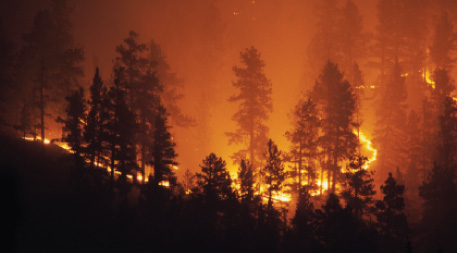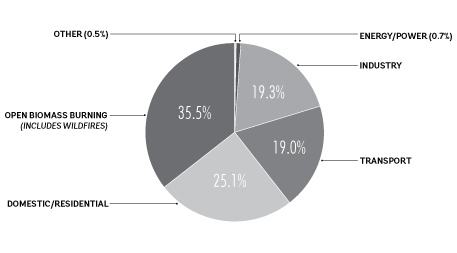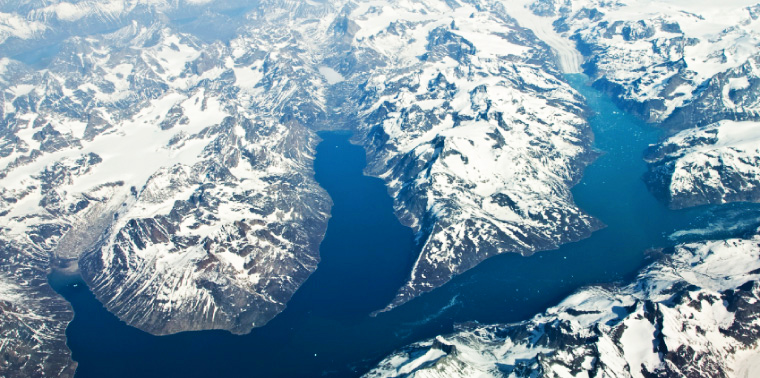July 15, 2013 — On many maps of the world, Greenland appears as a winter-white wedge floating in a dark blue sea. But in recent summers, some parts of Greenland would be better depicted in various shades of gray. Greenland is growing darker, even in areas covered in ice and snow.
This is a problem, and not just an aesthetic one. When light hits white, freshly fallen snow, it’s bounced about by the snow’s crystals, and most of its energy — up to 90 percent — ends up reflected away. But darkened snow and ice absorb more sunlight, warming ice sheets and speeding the rate at which glaciers melt. Between 2000 and 2011, glaciologist Jason Box estimates that darkened ice caused the Greenland ice sheet to absorb an extra 172 quintillion joules of energy — enough to double melt rates.
In one of the troubling feedback loops of the changing climate, dark ice is partially caused by the warmer Arctic summers climate change has brought us: More warmth means less fresh snowfall to cover areas of accumulated sediment, changes to the shape and size of ice grains that make them less reflective, and more liquid near the surface. It may also mean more habitat for dark microbes, which can contribute to the darkening of the ice sheets and therefore to the melting.
But warming isn’t enough to explain all of Greenland’s darkness. Another culprit is black carbon, better known as soot.
Black carbon is a by-product of burning biomass, coal, diesel and gas. It comes from, among other things, inefficient stoves, diesel trucks, campfires and fires in forests and savannas. Black carbon particles are most concentrated over cities, but wind carries them all over the world before they settle out of the atmosphere or are washed to Earth by precipitation. When they fall in the Arctic, they help turn bright snow gray — just as snowbanks on roadsides turn dingy by winter’s end.
Black carbon is a much more important player in climate change than once thought.
And black carbon’s impact isn’t confined to the Arctic. It also alters the atmosphere in ways we don’t fully understand: affecting cloud cover, absorbing the sun’s heat and warming the air. Recent studies have shown that black carbon has a complex but powerful impact on global climate change — and could offer an important opportunity for slowing it down.
Black Carbon’s Climate Role
We’ve known for some time that black carbon plays a role in climate change, but such a complicated one that it’s difficult to define or quantify. In January of this year, 31 scientists published the results of a four-year collaboration to analyze and synthesize what we know about black carbon’s contributions in the Journal of Geophysical Research: Atmospheres. Their key finding? “We were underestimating warming via black carbon by a factor of two,” says Patricia Quinn, an atmospheric chemist who contributed to the study.
Black carbon, in other words, is a much more important player in climate change than once thought. In fact, the study found that it is the second largest contributor after carbon dioxide, trapping more heat than methane, which was previously thought to be second.
Still, Sarah Doherty, a research scientist at the University of Washington who is lead author of the study, cautions that one of the study’s main lessons is how difficult it is to disentangle the effects of black carbon from other emissions. The study leaves a large range of uncertainty in how much warming black carbon actually causes. One reason is that the same fires and factories that produce black carbon also produce other particulates and gases that actually have a cooling effect on the climate. “You can’t just go and pluck black carbon out of the atmosphere and not affect other things,” she says. “We need to make sure we’re always thinking about this in a comprehensive way.”

Open biomass burning is the largest source of black carbon worldwide, followed by residential energy. ©iStockphoto.com/milehightraveler
Black carbon’s impact on snow and ice — not just in the Arctic but on mountain ranges from the Rockies to the Himalayas — is somewhat easier to pin down. “That’s a very definite, instantaneous impact where you have this black stuff absorbing radiation and helping enhance the melting,” says Quinn.
Arctic Feedback Loops
In the summer of 2012, Box was on his way back to Greenland when he saw reports of record wildfires in his home state of Colorado on airport televisions. He wondered what impact soot from the fires — and others raging closer to the Arctic, including the largest tundra fire in history — might have on the ice sheets. He’d been studying changes in Greenland’s albedo (the scientific term for the reflectivity of ice), but hadn’t focused on the role of black carbon.
Just weeks later, Greenland was grabbing headlines: 97 percent of the surface of its massive ice sheet had melted to slush, with most of the melt occurring in just four days. The level of melting was so extraordinary, the NASA scientist who noticed it said in a statement, “I at first questioned the result: Was this real or was it due to a data error?”
It was real. And Box believes black carbon from increasingly common tundra wildfires may have played a role. This summer he will return to Greenland with a team of researchers to try to clarify what role black carbon from wildfires (which, in another feedback loop, are made worse by climate change) and other sources may have played. Box describes the Dark Snow Project as “a focused science collective” — a chance for scientists from a variety of disciplines to take a closer look at black carbon. They plan to drill short ice core samples and analyze the past role of black carbon, including layers from 2012 (though Doherty points out that it may be difficult to tell how much black carbon was deposited then, rather than deposited in earlier years and concentrated by the melting). “If we can get at the nexus between human activity and the reflectivity of the ice sheet, that’s ultimately what we’re after,” says Box.
McKenzie Skiles, a snow hydrologist with the Dark Snow Project, studies the impact dark impurities have on snow melt in Greenland.
Understanding that nexus will mean trying to parse the complex interplay of shifting Arctic conditions — how changes in temperature, cloud makeup, albedo and even biology interact with each other, and how those interactions may create unexpected results. “Just in the last decade there have been a number of scientific epiphanies that make us realize that the climate system is more sensitive than we once had thought,” explains Box. “These multipliers in the system — these feedback loops — that’s how change happens in surprising ways.”
Which is why Marek Stibal, a glaciologist and geochemist based in Copenhagen, is joining the research team. “We like to think of the Greenland ice sheet as an ecosystem,” he says. “If you talk to glaciologists, they usually don’t appreciate the fact that it’s a living thing. It has a biological component to it. It’s not dead, it’s not lifeless.”
The good news is that black carbon’s outsize influence may make it a powerful lever for combating climate change.
Stibal has shown that microbes growing on the ice are part of the reason it’s darkening. Living on bright ice is a tough gig, so certain kinds of algae produce dark pigments to protect themselves from being harmed by too much solar radiation. “We think that the pigment is probably the adaptation that they evolved to survive in this environment,” says Stibal. Microbes also create a gluelike substance that helps sediment stick to the surface of ice sheets and causes it to clump together, which can also speed melting.
And melting is just what microbes need to grow: Even microbes that survive on ice sheets depend on some liquid water. As more of the ice melts, more area is opened to microbial growth, meaning more darkening — and more melting. Before the record melt last summer, says Stibal, the largest zone with liquid water had been around 200,000 square kilometers. Suddenly, it was nearly the entire 1.7 million square kilometer ice sheet. “That’s a huge difference, and there’s a huge potential for biology to start feeding back into the system once it gets going,” he says.

Global Black Carbon Emissions (from 2000). Source: United States Environmental Protection Agency.
It’s not yet clear whether the 2012 melt period was long enough for microbes to grow significantly, but anticipated future melts likely will be. “The more meltwater you will generate on the surface, the more algae you will get growing there, the more melting — and that’s the feedback loop,” says Stibal.
There may even be further feedback if microbes turn out to consume nutrients in black carbon, a possibility Stibal hopes to test this summer.
Chance for Change
The good news is that black carbon’s outsize influence may make it a powerful lever for combating climate change. While CO2 can stay in the atmosphere for hundreds of years, black carbon is typically washed out by precipitation within days or weeks. By reducing black carbon emissions, “we’d get a much more rapid response in the warming than reducing something like CO2,” says Quinn.
Tackling climate change still demands a dramatic reduction in our CO2 emissions — there’s no getting around that fact. But the possibility of a quick impact means that reducing black carbon emissions may be a way to buy ourselves more time to deal with CO2. Testifying before Congress on the subject of black carbon in 2010, Veerabhadran Ramanathan of the Scripps Institution of Oceanography observed that policymakers could “have a unique opportunity to witness the success of their mitigation efforts during their tenure.”
Scientists are beginning to trace black carbon found in the Arctic back to its origins — following the wind patterns that delivered it, or analyzing chemicals and gases that accompany it to find out what we burned to create it. The issue now, says Quinn, is “to figure out where the black carbon is coming from and what sources you should be mitigating to get the best results in the Arctic.”
That was one goal of the recent study that looked at black carbon’s role in climate change. Since different point sources of black carbon can have such varied impacts on the climate, its authors hoped to identify which ones contribute the most to warming and are therefore particularly urgent to target. Diesel fuel — used in trucks, tractors, construction equipment and elsewhere — emerged as the clearest offender. Inefficient cookstoves in the developing world are also a straightforward target. And reducing black carbon emitted in or near the Arctic (or other areas dominated by ice) is a clear gain, whether from oil flaring in Siberia or marine shipping.
The study points out a further complication: As with other contributors to climate change, reducing black carbon emissions involves political and economic issues that are just as complex as the science. Still, a number of international bodies are making commitments to address black carbon and other short-lived climate pollutants. And with the catastrophic impacts of the climate crisis bearing down on us, it’s no small thing to be presented with a clear set of possibilities for quickly and significantly slowing warming.
![]()
Ensia shares solutions-focused stories free of charge through our online magazine and partner media. That means audiences around the world have ready access to stories that can — and do — help them shape a better future. If you value our work, please show your support today.
Yes, I'll support Ensia!
